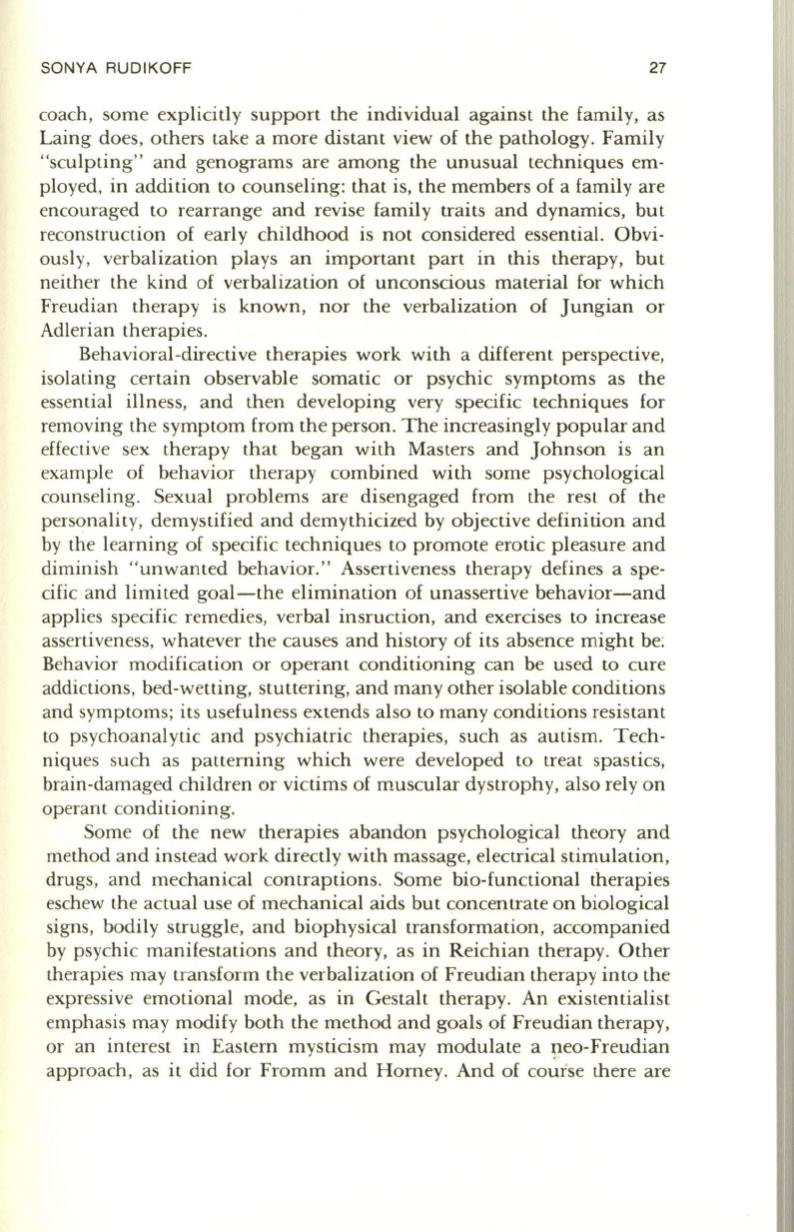
SONYA RUDIKOFF
27
coach, some explicitly support the individual against the family, as
Laing does, others take a more distant view of the pathology. Family
"sculpting" and genograms are among the unusual techniques em–
ployed, in addition to counseling: that is, the members of a family are
encouraged to rearrange and revise family traits and dynamics, but
reconstruction of early childhood is not considered essential. Obvi–
ously, verbalization plays an important part in this therapy, but
neither the kind of verbalization of unconscious material for which
Freudian therapy is known, nor the verbalization of Jungian or
Adlerian therapies.
Behavioral-directive therapies work with a different perspective,
isolating certain observable somatic or psychic symptoms as the
essential illness, and then developing very specific techniques for
removing the symptom from the person. The increasingly popular and
effective sex therapy that began with Masters and Johnson is an
example of behavior therapy combined with some psychological
counseling. Sexual problems are disengaged from the rest of the
personality, demystified and demythicized by objective definition and
by the learning of specific techniques to promote erotic pleasure and
diminish "unwanted behavior." Assertiveness therapy defines a spe–
cific and limited goal-the elimination of unassertive behavior-and
applies specific remedies, verbal insruction, and exercises to increase
assertiveness, whatever the causes and history of its absence might be:
Behavior modification or operant conditioning can be used to cure
addictions, bed-wetting, stuttering, and many other isolable conditions
and symptoms; its usefulness extends also to many conditions resistant
to psychoanalytic and psychiatric therapies, such as autism. Tech–
niques such as patterning which were developed to treat spastics,
brain-damaged children or victims of muscular dystrophy, also rely on
operant conditioning.
Some of the new therapies abandon psychological theory and
method and instead work directly with massage, electrical stimulation,
drugs, and mechanical contraptions. Some bio-functional therapies
eschew the actual use of mechanical aids but concentrate on biological
signs, bodily struggle, and biophysical transformation, accompanied
by psychic manifestations and theory, as in Reichian therapy. Other
therapies may transform the verbalization of Freudian therapy into the
expressive emotional mode, as in Gestalt therapy. An existentialist
emphasis may modify both the method and goals of Freudian therapy,
or an interest in Eastern mysticism may modulate a peo-Freudian
approach, as it did for Fromm and Horney. And of course there are


